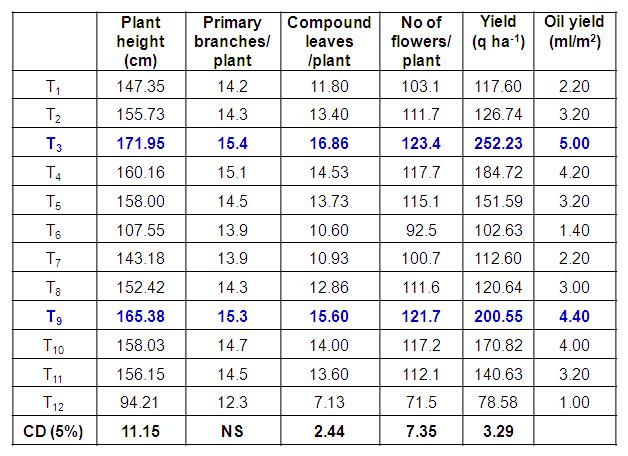Preamble
Wild marigold is a tall annual herb with pale yellow flowers, having a very strong and sharp smelling property. This herb has aromatic, antispasmodic, diuretic and purgative and also has digestive, vermifuge and very strong insecticide properties. The herb is grown with cultivated crops to deter insects, (specifically eel worms that react well to the thiophenes contained in the roots of the wild marigold plant) slugs and other pests, as well as weeds. It can be used to treat gastritis, indigestion and intestinal worms. Externally the herb has a positive effect on skin infections and is also used on hemorrhoids.
Table 5.4: Effect of organics on yield attributes and yield of Wild marigold

T1= FYM @20t/ha + vermicompost @15t/ha & Panchang; T2= T1 + biopesticide; T3= T1 + Agnihotra ash; T4= T1 + Bt & Himbio; T5= T1 + BD 500; T6= Control + Panchang; T7= FYM @20t/ha + vermicompost @15t/ha & Non Panchang; T8= T7 + biopesticide; T9= T7 + Agnihotra ash; T10= T7 + Bt & Himbio ; T11= T7 + BD 500; T12= Control + Non Panchang
Discussion
A critical study of the table 5.4 reveals that effect of sowing according to Panchang was significant in increasing the yield attributes and thus the yield over the Non Panchang sowing. The increase in yield in Panchang sowing was 30.6 and 25.77 per cent in control and Agnihotra ash, respectively. In other treatments it varied from 4.44 to 8.14 per cent. The treatment T3 (Org. manure + Agnihotra ash + Panchang) was found to be significantly best in increasing the yield of wild marigold. While, the lowest yield was recorded in T12 (Control + Non Panchang).
Among all the treatment where organics were added T3 (Org. manure + Agnihotra ash + Panchang) was the best which was closely followed by T9 (Org. manure + Agnihotra ash + Non Panchang) treatment. The third best treatment was T4 (Bacillus thuringiensis & Himbio + Panchang).
These results clearly indicate the importance of sowing according to Panchang and Agnihotra ash application increasing produce quality and quantity.
Conclusions
To sum up, it has been clearly demonstrated in this experiment that in aloe vera, addition of Agnihotra ash was significantly superior to other organic treatments. It significantly affected the growth and yield attributes of all the crops.

